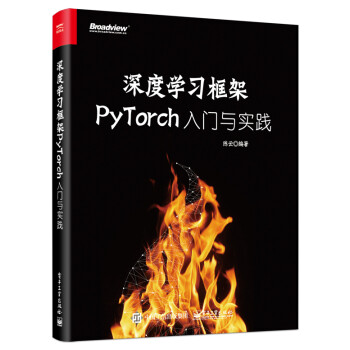baifengbai / Pytorch_learning
Labels
Projects that are alternatives of or similar to Pytorch learning
这是书籍《深度学习框架PyTorch:入门与实践》的对应代码,但是也可以作为一个独立的PyTorch入门指南和教程。
内容
可以看出本教程可以分为两部分:
基础部分(前五章)讲解PyTorch内容,这部份介绍了PyTorch中主要的的模块,和深度学习中常用的一些工具。对于这部分内容,这里利用Jupyter Notebook作为教学工具,读者可以结合notebook修改运行,反复实验。
- 第二章介绍如何安装PyTorch和配置学习环境。同时提供了一个快速入门教程,基于官方的教程简化并更新内容,读者可以花费大约1到2小时的时间快速完成入门任务,而后根据需求再选择深入阅读后续相关章节的内容。
- 第三章介绍了PyTorch中多维数组Tensor和动态图autograd/Variable的使用,并配以例子,让读者分别使用Tensor和autograd实现线性回归,比较二者的不同点。除了介绍这二者的基础使用之外,本章还对Tensor的底层设计,以及autograd的计算图原理进行比较深入分析,希望能使得读者能对这些底层知识有更全面的掌握。
- 第四章介绍了PyTorch中神经网络模块nn的基础用法,同时讲解了神经网络中“层”,“损失函数”,“优化器”等,最后带领读者用不到50行的代码搭建出曾夺得ImageNet冠军的ResNet。
- 第五章介绍了PyTorch中数据加载,GPU加速,持久化和可视化等相关工具。
实战部分(第六到十章)利用PyTorch实现了几个酷炫有趣的应用,对于这部分的内容,本仓库给出完整的实现代码,并提供预训练好的模型作为demo,供读者测试。
- 第六章是承上启下的一章,这一章的目标不是教会读者新函数,新知识,而是结合Kaggle中一个经典的比赛,实现一个深度学习中比较简单的图像二分类问题。在实现过程中,带领读者复习前五章的知识,并提出代码规范以合理的组织程序,代码,使得程序更加可读,可维护。第六章还介绍了在PyTorch中如何进行debug。
- 第七章为读者讲解了当前最火爆的生成对抗网络(GAN),带领读者从头实现一个动漫头像生成器,能够利用GAN生成风格多变的动漫头像。
- 第八章为读者讲解了风格迁移的相关知识,并带领读者实现风格迁移网络,将自己的照片变成高大上的名画。
- 第九章为读者讲解了一些自然语言处理的基础知识,并讲解了CharRNN的原理。而后利用收集了几万首唐诗,训练出了一个可以自动写诗歌的小程序。这个小程序可以控制生成诗歌的格式,意境,还能生成藏头诗。
- 第十章为读者介绍了图像描述任务,并以最新的AI Challenger比赛的数据为例,带领读者实现了一个可以进行简单图像描述的的小程序。
- 第十一章(新增,实验性) 由Diamondfan 编写的语音识别。完善了本项目(本项目已囊括图像,文本,语音三大领域的例子)。
Notebook中的文字描述内容属于本书的初稿,有描述不通顺,错别字之处还请谅解。本打算删除notebook中描述的内容,只留下代码,但为了方便读者阅读学习,最终还是决定留下。 我会抽空根据书中内容逐字校对这部分内容,但并不对此并不提供具体时间点。
是否需要买书
书不是必要的,这个仓库包含书中50%以上的文字内容,90%以上的代码,尤其是前几章入门内容,几乎是完全保留了书中的讲解内容。读者即使不买书也能正常使用本教程。
如果你觉得纸质书的优势吸引你,不妨小破费一笔,支持一下作者这大半年来的工作。同时为了尽可能的方便读者,笔者还专门开通腾讯云的服务,用以保存教程中用到的部分模型,预处理的数据和部分大文件。
代码说明
- 教程代码同时在Python2和Python3下测试通过
- 实战部分代码还同时在GPU和CPU环境下测试通过
-
所有的代码都是基于最新版的PyTorch 0.2.0,本人承诺会至少维护代码更新兼容到PyTorch0.4
目前前五章的代码已经更新到PyTorch 0.3.0 , 如果你想在PyTorch 0.2.0下运行,请
git checkout v0.2
如果有任何不当,或者有待改进的地方,欢迎读者开issue讨论,或者提交pull request。
环境配置
-
安装PyTorch,请从官网选择指定的版本安装即可,一键安装(即使你使用anaconda,也建议使用pip)。更多的安装方式请参阅书中说明。
-
克隆仓库
git clone https://github.com/chenyuntc/PyTorch-book.git
-
安装第三方依赖包
cd pytorch-book && pip install -r requirements.txt
Visdom打不开及其解决方案
新版的visdom已经解决了这个问题,只需要升级即可
pip install --upgrade visdom
之前的解决方案 不再需要,已删除。
^_^
有任何bug,解释不清楚的地方或者是困惑,欢迎开issue
欢迎pull requests
Happy Coding!


